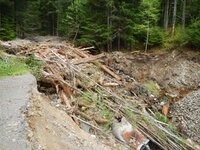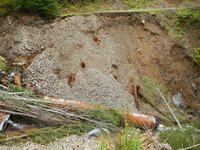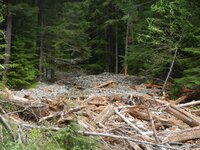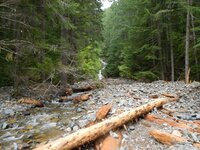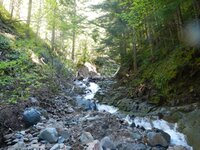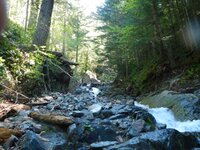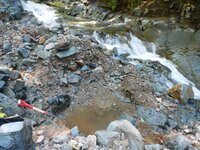Ragnor
Sr. Member
- Dec 7, 2015
- 445
- 422
- Primary Interest:
- All Treasure Hunting
So lets say you have this creek. The average grade of the slope over several miles is above 40% slope. It's steep. The stream bed is 10'-15' wide, walled on both sides by slopes averaging 60% grade. Nigh impassable. The entire course is on bedrock with small deposits of alluvium in the few flatter area's 10'-50' long. There are also several log jams. Now at some point a land slide occurs during rapid snow melt. A dam or dams is formed high on the slope. A landslide occurs higher still flowing down the creek at high velocity. It plows into these log dams, bursting them as it goes. This adds exponential volumes of water and debris as it accelerates down the steep bedrock slope of the creek. The steep walls of the ravine containing and guiding this massive slurry of earth and stone and logs. A surge wall some 30+ feet tall of churning doom comes slamming down the canyon with unimaginable force. Not even bedrock dikes can withstand the force of this moving mass and are torn away and added to the slurry.
Now at a lower point a road grade has been established that crosses this ravine. Rock has been filled over a culvret some 75 feet high at the crossing point and a large volume of material has filled in above the road grade from a previous flood event some 20 years ago. The force of this massive land slide tearing down the valley comes bounding off of a waterfall at rediculous speed carrying unquantifyable amounts of energy. The mass of this moving volume strikes the lower staionary deposit and road grade with such force that it literally explosively replaces the former deposit. My best analogy is croquet, when you whack one ball with another and take it's place.
Standing in the creek bed imagining what that actually would have been like to experience is truelly a terrifying wonder. I have seen evidence that at least one elk experienced this horror first hand. It's bones are litterally stripped clean and skattered along the stream course lower down.
The material that came to rest at the base of the old waterfall is completely unsorted. Large logs are covered by boulders and gravel and jut out at every angle. The gravels show little or no sign of bedding or sorting.
So I ask, in a scenario like this where does the gold deposit? Will it be mixed in all throughout the debris deposit? Will it be under the one or two logs that miraculously filled a low pressure zone and remained in the stream bed? So far I have focused on the areas with the largest boulders and the shallowest bedrock. But I still feel I am missing something. Has anyone on here ever successfully explored a flood/landslide deposit like this and figured out where the gold had a tendancy to accumulate? If so, do you mind filling me in on this non standard type of stream bed erosion and sorting?
My best method so far has been metal detecting for pieces of iron that came down from old mines and then cleaning out the areas where I find them.
Now at a lower point a road grade has been established that crosses this ravine. Rock has been filled over a culvret some 75 feet high at the crossing point and a large volume of material has filled in above the road grade from a previous flood event some 20 years ago. The force of this massive land slide tearing down the valley comes bounding off of a waterfall at rediculous speed carrying unquantifyable amounts of energy. The mass of this moving volume strikes the lower staionary deposit and road grade with such force that it literally explosively replaces the former deposit. My best analogy is croquet, when you whack one ball with another and take it's place.
Standing in the creek bed imagining what that actually would have been like to experience is truelly a terrifying wonder. I have seen evidence that at least one elk experienced this horror first hand. It's bones are litterally stripped clean and skattered along the stream course lower down.
The material that came to rest at the base of the old waterfall is completely unsorted. Large logs are covered by boulders and gravel and jut out at every angle. The gravels show little or no sign of bedding or sorting.
So I ask, in a scenario like this where does the gold deposit? Will it be mixed in all throughout the debris deposit? Will it be under the one or two logs that miraculously filled a low pressure zone and remained in the stream bed? So far I have focused on the areas with the largest boulders and the shallowest bedrock. But I still feel I am missing something. Has anyone on here ever successfully explored a flood/landslide deposit like this and figured out where the gold had a tendancy to accumulate? If so, do you mind filling me in on this non standard type of stream bed erosion and sorting?
My best method so far has been metal detecting for pieces of iron that came down from old mines and then cleaning out the areas where I find them.
Upvote
0




